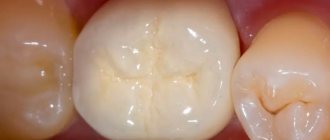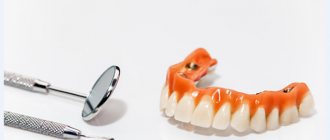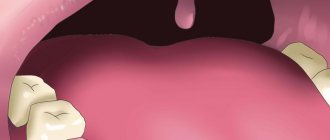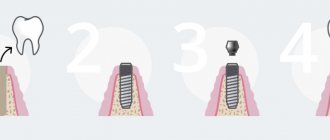Modern dental prosthetics can completely restore the aesthetics of the dentition and its chewing functions. People may face the need for surgical removal at any age. Among the achievements of orthopedic dentistry, anyone can choose a suitable replacement option. Dental prostheses are produced in different types, differing in the material of manufacture, cost, and service life. For the production of structures, alloys of precious metals, ceramics, special plastics, polymers, nylon and other types of raw materials are used.
There are two types of prosthetics after tooth extraction:
- Removable dental structures can be removed and put on by the patient as needed. The products are attached to the supporting teeth using hooks or micro-locks. For edentulous patients, models are used that are fixed to the gums using suction cups or a special gel.
- Fixed dentures are installed in the jaw (implants) or attached to supporting teeth (bridges).
Each category is represented by several options. Among them, dentists select the appropriate solution based on the condition of the oral cavity and the health of the patient.
Depending on the service life of the products, temporary and permanent dentures are distinguished. Models of the first type are designed to last only a few months. The products are used to temporarily close the postoperative gap.
Fixed dentures remain the most popular way to restore the beauty of a smile. This replacement option is more convenient compared to removable devices. It is easy to care for and helps preserve the natural functions of the dental system. Permanent prosthetics are performed in different ways:
- The installation of crowns made of metal ceramics or a metal alloy is performed on a previously prepared tooth. This method is used if the root is intact, but the top is destroyed.
- Implantation of one or more teeth involves inserting an artificial root into the jaw. A permanent or temporary crown is placed on it. This method is indicated for complete or partial edentia. Sometimes doctors use an implant as a support for a bridge.
- Bridges are placed after the amputation of several teeth located nearby.
- Adhesive structures are secured using an adhesive solution. In this case, there is no need to depulp the adjacent teeth. This restoration method is one of the most technologically advanced in orthopedic dentistry.
Prosthetics after tooth extraction and indications for the procedure
Installation of a denture allows you to completely restore the functional and aesthetic properties of the jaw apparatus. The indication for the procedure is single or multiple damage to the jaw as a result of trauma, surgical amputation due to advanced caries, or other diseases of the oral cavity.
If the crown is partially destroyed, a microprosthesis is installed instead of the usual one. This group includes inlays, veneers and ultraneers. The products effectively solve aesthetic problems with minimal trauma to natural bone and gum tissue.
Cost of services
The cost of services depends on:
- The number of missing elements of the dentition.
- The type of prosthesis or implants chosen.
- Difficulties in carrying out all manipulations, etc.
We don't inflate prices. Thanks to this, restoration is possible even on a limited budget. The doctor will draw up a financial treatment plan in advance. This will allow you to plan your expenses. In addition, we provide discounts and run special promotions. Thanks to this you can save money.
Contraindications
Thanks to the variety of techniques for each person, you can choose a way to restore the beauty of your smile. All dentures have indications for use and contraindications. The decision to replace a lost element after amputation is made by the attending physician based on the results of dental diagnostics, taking into account the age and condition of the body.
As for the general reasons, experts do not recommend performing surgical procedures if you are pregnant, undergoing rehabilitation after a serious illness or complex operation, or are sick with ARVI. You should not install implants or dentures during periods of exacerbation of chronic diseases, exhaustion or acute stress.
Tell your doctor if you are allergic to anesthetics or take any medications. Some drugs affect blood clotting and the rate of tissue regeneration. This can create problems during the procedure and while the wound is healing.
Often, poor oral hygiene is an obstacle to treatment. This temporary contraindication can be eliminated through therapeutic measures.
Features of dental prosthetics
- Fixed restoration using stump inlays, crowns and bridges is possible within 7-10 days after removal. The exact time for the start of recovery depends on the body’s reaction (the presence of inflammation or its absence), the traumatic nature of the intervention and other factors.
- Prosthetics with removable dentures. Recovery is possible 1-4 weeks after removal.
- Implantation. Dental prosthetics can be carried out either immediately (if you choose a one-step technique) or after 1-2 months (the time is necessary for the socket to heal).
Note! Recovery within 24 hours is possible with prefabricated prostheses; preliminary comprehensive treatment planning will minimize discomfort after surgery. The structures are temporary and must be replaced in the future.
Indications for postoperative recovery are:
- Loss of frontal row elements associated with psychological and physical discomfort.
- Adentia that occurs at an early age, which can lead to jaw deformation.
- Complete edentia in adults.
- Loss of the last molars due to deep bite or pathologies of the temporomandibular joint.
- Loss of extreme antagonists (molars whose surfaces are in contact with each other).
If there is no urgent need for recovery within 24 hours, prostheses are installed after a period of wound healing.
The doctor will tell you about all the features of the manipulations being performed.
Installation of the prosthesis immediately after removal (within 24 hours)
Clients are always interested in how many days after an injury or surgery they can get dentures. Dentistry has express methods for instantly eliminating smile defects. There is no need to hide an ugly gap from others and experience discomfort when communicating! We are talking about simultaneous implantation, which is performed in one stage. The dentist installs an artificial root into the resulting hole and immediately puts on a crown, which is prepared in advance. It creates a load on the jaw apparatus and prevents atrophy.
Another option is immediate dentures, which are temporary and are designed for 3-4 months of use.
Implants or dentures - which is better?
Many patients cannot choose whether to have implants or dentures; often the deciding factor is the price of dental services. At the initial stage of prosthetics, an impression is made, which serves as the basis for a permanent prosthesis. It is fixed to the teeth using crowns. This method has many disadvantages compared to implantation.
Disadvantages of dentures:
- poor fixation, discomfort when wearing, long addiction;
- uneven distribution of chewing load;
- short service life - only 5-7 years.
Advantages of implants: aesthetics, reliable fixation. The installation procedure can be carried out immediately after tooth extraction; the dentist must first make sure there are no contraindications.
Before the intervention, the tissue condition is also assessed. If necessary, lifting is done. The purpose of the procedure is to restore bone tissue. At the next stage, the abutment is installed and a permanent implant is installed on it. Restoration requires 3-4 visits to the dentist, the service life of the implant is 5-10 years. Prosthetics, provided that the rules for administering anesthesia are followed, are considered absolutely painless.
Expert opinion
Roman Borisovich Alekperov
orthopedic dentist
Experience: 24 years
If you are just planning to visit a surgeon for tooth extraction, consider the option of one-stage implantation. This unique method involves placing an implant into the resulting socket immediately after extraction. No additional manipulations - incisions or detachment of a mucosal flap, as with the classic protocol - are performed. This gentle method will allow you to resolve the issue of tooth restoration immediately at the time of its removal. Important: there are contraindications for immediate implantation! Please clarify the possibility of its use in your case during your consultation.
Prices for services
Consultation with a dentist - orthopedist Free Stump tab from RUB 3,900. up to 9500 rub. Ceramic inlay from 8200 rub. up to 17,500 rubles. Metal-ceramic crown CoCr from 7,200 rubles. up to 10,000 rubles. Metal-free ceramics 25,000 rubles. Ceramic veneers from 17,000 rubles. up to 30,000 rubles. Removable prosthesis 9,500 rubles. up to 18,000 rubles Clasp clasp prosthesis from 25,000 rubles up to 28,000 rubles Clasp monomer-free prosthesis 36,000 rubles Nylon prosthesis 15,000 rubles up to 34,000 rubles; metal ceramics for implants from 20,000 rubles. up to 25,000 rub.Disadvantages of methods
When choosing what to install, a bridge or an implant on a chewing tooth, you also need to take into account the disadvantages of the methods. For example, installing an artificial root is a traumatic procedure. Treatment periods reach three to six months; prices are high, since in addition to the prosthesis, you need to pay for the installation of an implant.
The disadvantages of bridge prosthetics include the lack of load on the bone, the need to grind and remove the pulp of adjacent teeth, and the risk of gum subsidence under the prosthesis. In addition, the service life of a dental bridge is relatively short, since teeth covered with crowns often have to be treated and even removed after several years. And then the patient bears the cost of making a new design or still spends money on implantation.
In view of the listed advantages and disadvantages, implants are recommended to be used to restore frontal and lateral teeth. With chewable units, options can be considered.
Problems with other teeth
Neighboring teeth gradually move to the place of the removed tooth. This leads to malocclusion. Also, in the first months after tooth loss, active bone resorption occurs. A depression forms in the gum above the empty socket. Because of this, the mucous membrane looks ugly.
The absence of even one tooth increases the load on other dental units. As a result, the enamel can wear off faster. This provokes the appearance of caries.
Misaligned teeth are more difficult to clean. Microbial plaque begins to form in hard-to-reach places. Gradually it turns into stone, provoking inflammatory processes and the progression of caries.
Removable dentures
A removable denture is a base made of plastic or nylon on which artificial porcelain or plastic teeth are attached. The structure is fixed in the mouth with micro-locks, clasps, telescopic crowns or due to the suction effect. Removable dentures are used for unlimited dental defects and complete absence of teeth.
There are several types of removable dentures based on the type of fastening and base material:
- clasp;
- nylon;
- plastic with silicone gasket;
- plastic partial or complete.
Conventionally, removable clasp dentures are fixed using telescopic crowns, attachments, and clasps. They are used only in cases of partial absence of teeth. It is the most comfortable, functional and durable type of removable dentures.
A soft nylon denture is recommended in partially edentulous cases. Fits well and is easy to use.
Plastic ones with a silicone gasket are also convenient. Dentures of this type adhere more tightly and put less pressure on the gums.
Plastic full or partial are an outdated type of dentures. A budget option, which is the basis of all social programs for free prosthetics. Plastic structures are poorly fixed in the oral cavity and cannot chew solid food well.
What is the essence of the methods?
Braces
Braces are orthodontic structures for correcting bites and moving teeth into the correct position. They are an arch with ligatures, dental clasps for fixation, made of metal, plastic, ceramics. There are:
- vestibular - installed on the outside of the teeth;
- lingual - fixed on the inside and not visible to others.
The purpose of the structures is to create pressure to move the tooth into the desired position.
The tooth root is connected to the bone tissue by ligaments. Under pressure they stretch, the crown and root parts move. The duration of treatment is determined individually, ranging from several months to several years.
Implantation
Implantation is a method of replacing a lost tooth with a titanium root and then installing an artificial crown on it.
The operation is performed under local anesthesia or sedation. The gums are peeled off, a hole is drilled in the bone tissue, into which a titanium rod is screwed. The implant is covered with gum, sutured and left alone until it engrafts with the bone. With classic two-stage implantation, the period lasts 3-6 months. After osseointegration, a crown is installed.
If there is not enough bone tissue, it is augmented before or during implantation. If osteoplasty is performed as a separate stage, it will take another 3-6 months for the bone material to heal.
Which way is better
Despite the variety of modern prosthetics, implantation is considered the best way to restore lost teeth. The main advantages of the surgical method:
- the result lasts for 10 years;
- original materials and protocols are guaranteed for life;
- bone atrophy stops;
- the prosthesis on implants is securely fixed;
- the risk of complications is minimal;
- artificial teeth on implants look and feel like natural teeth.










